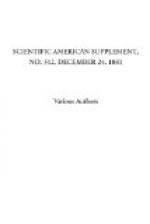It is not definitely known how much static caloric is occluded in either of the elementary bodies, but it is believed that hydrogen possesses the greatest amount and oxygen the least. Now if we take a molecule of hydrogen containing two atoms, and under proper conditions interpose these atoms between 16 atoms of oxygen (one molecule), the phenomenon of combustion is exhibited, and a molecule of water is formed containing 18 atoms; and if one pound of hydrogen is thus consumed, the atoms of hydrogen are separated from each other to such a distance by the interposing atoms of oxygen as to unlock 34,662 units C. of static, and convert it into dynamic caloric. And if we thus bring a molecule of carbon containing 12 atoms in contact with a molecule of oxygen of 16 atoms, combustion ensues and a molecule of carbonic oxide of 28 atoms is formed, and if we then present another molecule of oxygen, combustion again takes place, and a molecule of carbonic acid, containing 44 atoms, is produced. Now, in the combustion of one pound of carbon in this manner, when the carbon is converted into carbonic oxide (CO), 2,473 units C. of static is converted into dynamic caloric; and when this CO is converted into carbonic acid (CO_{2}) 5,607 additional units C. are unlocked. Thus by the combustion of one pound of carbon to CO_{2}, 8,080 units C. of static caloric are changed to dynamic caloric.
When caloric is thus unlocked from its occlusion it escapes with great velocity until an equilibrium is attained, and in doing so it pushes the particles of matter out of its path. In solid bodies this produces such a high degree of molecular movement as to exhibit the phenomena of incandescence and luminosity, and in liquids increased mobility, while in gases the molecular activity may be so great as to produce the phenomena of sound and light; and the more rapidly combustion takes place the greater will be the volume and velocity of dynamic caloric escaping therefrom; consequently with a slow combustion, the phenomena produced by dynamic caloric will be different from those exhibited at a high degree.
Combustion, as I have before shown, is merely the oxidation of the material; nothing is consumed nor annihilated, and, the phenomena vary with the velocity of oxidation. Now, if we take one pound of zinc and place it in the acid cell of an electric battery, the oxygen of the acid attacks the zinc and oxide of zinc is formed. In this operation the Zn molecule containing 65 atoms is united with one molecule of oxygen of 16 atoms, forming a molecule of oxide of zinc (ZnO) of 81 atoms; and owing to the comparatively small number of oxygen atoms interposed between the 65 atoms of zinc, only 1,301 units C. of static caloric are unlocked to the pound of zinc, and the velocity of oxidation is so low, and the insulation of the vessel so perfect, that the dynamic caloric is caused to flow outward through the copper wire.




